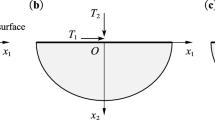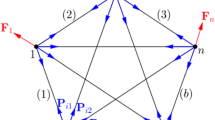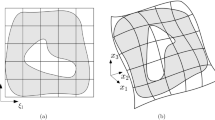We propose two approaches to the solution of problems of antiplane deformation of bounded bodies with thin-walled defects by concentrated factors. The first is a numerical approach based on the boundary element method, in which the Volterra approach was developed to take into account the action of screw dislocations, and special tip boundary elements were introduced to determine the stress intensity factors. The second is an analytic-numerical method of direct full cutting, in which bounded bodies are modeled by using a space with a system of inhomogeneities contacting with each other, and, at the contact points, certain a priori unknown concentrated forces and dislocations act, which enables us to increase substantially the accuracy of computations for a small size of the resultant system of equation. Specific numerical examples for a body (bar) with a square cross-section containing a strip crack or rigid inclusion under the action of concentrated forces and screw dislocations have been considered.
Similar content being viewed by others
References
V. V. Bozhydarnyk and H. T. Sulym, Elements of the Theory of Plasticity and Strength [in Ukrainian], Svit, Lviv (1999).
V. V. Bozhydarnyk and H. T. Sulym, Elements of the Theory of Elasticity [in Ukrainian], Svit, Lviv (1994).
K. V. Vasil’ev and H. T. Sulym, “Direct cutting method for simulating the stress-strain state of isotropic layered environments with thin inhomogeneities under antiplane deformation,” Mashynoznavstvo, No. 11–12, 10–17 (2006).
K. V. Vasil’ev and H. T. Sulym, “Solution of integral equations of problems of layered environments with arbitrary oriented strip inhomogeneities by the collocation method,” Visn. L’viv. Univ., Ser. Prykl. Mat. Informat., Issue 15, 157–169 (2009).
K. Vasil’ev, Ya. Pasternak, and H. Sulym, “Antiplane deformation of a body square in plan with an internal thin inhomogeneity,” Visn. L’viv. Univ., Ser. Mekh.-Mat., Issue 73, 165–176 (2010).
V. V. Panasyuk, Mechanics of Quasibrittle Fracture of Materials [in Russian], Naukova Dumka, Kiev (1991).
M. P. Savruk and A. M. Osechko, “Longitudinal shear of an infinite body with a system of polygonal cracks,” Fiz.-Khim. Mekh. Mater., 39, No. 5, 49–58 (2003); English translation: Mater. Sci., 39, No. 5, 658–671 (2003).
G. T. Sulym, “Antiplane problem for a system of linear inclusions in an isotropic environment,” Prikl. Mat. Mekh., 45, No. 2, 308–318 (1981).
H. T. Sulym, Fundamentals of the Mathematical Theory of Thermoelastic Equilibrium of Deformable Solid Bodies with Thin Inclusions [in Ukrainian], NTSh, Lviv (2007).
E. E. Gdoutos, “Failure of a composite with a rigid fiber inclusion,” Acta Mech., 39, No. 3–4, 251–262 (1981).
E. E. Gdoutos, Fracture Mechanics, Springer, Dordrecht (2005).
E. Pan and B. Amadei, “Fracture mechanics analysis of 2D anisotropic media with a new formulation of the boundary element method,” Int. J. Fracture, 77, 161–174 (1996).
Ia. Pasternak, “Coupled 2D electric and mechanical fields in piezoelectric solids containing cracks and thin inhomogeneities,” Eng. Anal. Bound. Elem., 35, No. 4, 678–690 (2011).
Ia. M. Pasternak and H. T. Sulym, “Thin inclusions theory integral equations numerical solution using the boundary element method procedure,” in: Proc. of the Int. Conf. “Integral Equations–2010” (August 25–27, 2010, Lviv), PAIS, Lviv (2010), pp. 104–108.
A. Portela, M. H. Aliabadi, and D. P. Rooke, “The dual boundary element method: effective implementation for crack problems,” Int. J. Numer. Meth. Eng., 33, 1269–1287 (1992).
W. Wei-Liang, “Dual boundary element method applied to antiplane crack problems,” Math. Probl. Eng., ID 132980 (2009); doi: 10.1155/2009/132980.
X. S. Zhang, “A tearing mode crack located anywhere in a finite rectangular sheet,” Eng. Fract. Mech., 33, No. 4, 509–516 (1989).
Author information
Authors and Affiliations
Additional information
Translated from Matematychni Metody ta Fizyko-Mekhanichni Polya, Vol. 55, No. 1, pp. 72–83, January–March, 2012.
Rights and permissions
About this article
Cite this article
Pasternak, I.M., Vasil’ev, K.V. & Sulym, H.T. Antiplane deformation by concentrated factors of bounded bodies with cracks and rigid inclusions. J Math Sci 190, 710–724 (2013). https://doi.org/10.1007/s10958-013-1282-0
Received:
Published:
Issue Date:
DOI: https://doi.org/10.1007/s10958-013-1282-0




